|
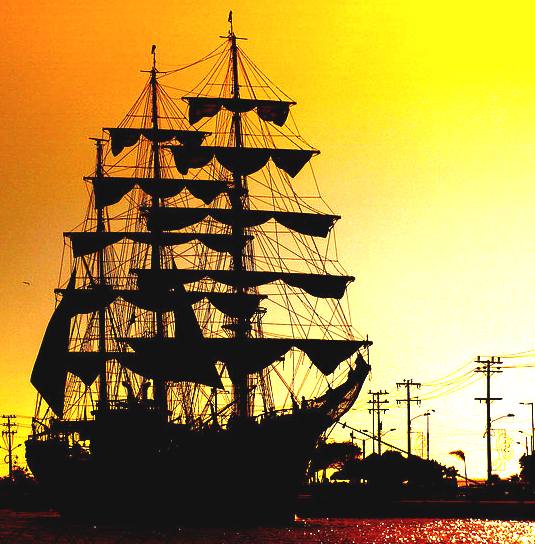
The term 'sailing ship' refers to any large, wind-powered vessel. In technical terms, a ship was a sailing vessel with a specific rig of at least three masts, square rigged on all of
them. The size of a vessel thus determined if she was a ship or a boat. In popular usage
the word 'ship' became associated with all large sailing vessels and when steam power came along,
the term motor-sailor was introduced, now used on quite small boats.
VARIATION
There are many different types of sailing ships, but they all have certain basic things in common. Every sailing ship has a hull, rigging and at least one mast to hold up the sails that use the wind to
propel the ship. The most well known sailing types are: Galleon, Clipper, Schooner,
Cutter, Frigate, Sloop, Ketch, Windjammer and Junk - all of which names refer to
the type of rig and number of masts. The crew who sail a ship are called sailors or hands.
The most important function of the crew was to raise and lower sails and steer
the ship. The crew took turns in taking a watch, a watch meaning the quotient of
crew actively managing the ships performance at any one time. Watches are traditionally four hours long. Some sailing ships use traditional ship's bells to tell the time and regulate the watch system, with the bell being rung once for every half hour into the watch and rung eight times at watch end. 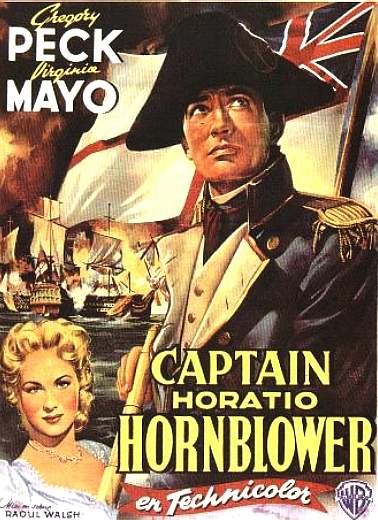

Those were the days. Not a computer in sight, just the wind, a sextant and
a hearty crew lashed up with grog. In those days hard discipline and a
skilled captain were the ingredients to a successful engagement. Admiral
Nelson was one of the finest English captains, and a fearless leader. The
Horatio Hornblower and Jack Aubrey adventures were inspired by the
exploits of Horatio
Nelson and other sea captains of the day.
Ocean journeys
made by sailing ships can take many months, and a common hazard is becoming becalmed because of lack of wind, or being blown off course by severe storms or winds that do not allow progress in the desired direction. A severe storm could lead to shipwreck, and the loss of all hands.
A sail powered sailing ship is rather more at the mercy of the elements from her
sails, and that is something naval architects seek to remedy, but research
funding is in the doldrums. Sailing ships are limited in their maximum size compared to ships with heat engines, so economies of scale are also limited. The heaviest sailing ships (limited to those vessels for which sails were the primary means of propulsion) never exceeded 14,000 tons displacement. Sailing ships are therefore also
restricted in the supply capacity of their holds, so they have to plan long voyages carefully to include
stops to take on provisions and fresh water, unless they carry a water maker.
That is one reason beer was popular onboard, because beer did not go off. A
drawback was being intoxicated, hence the naval term "grog," from
feeling groggy the day after drinking too much beer. 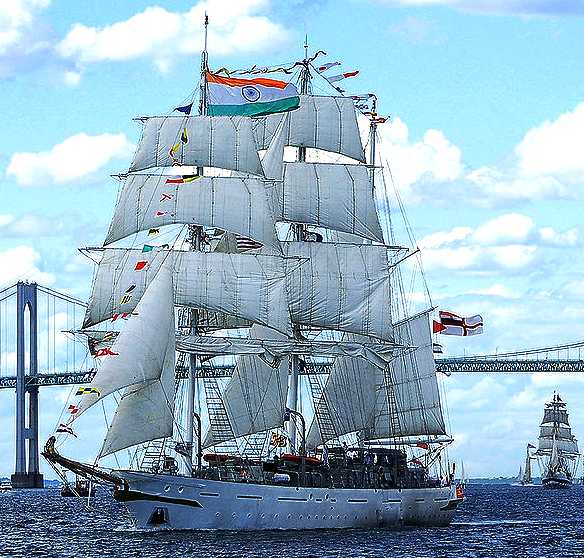
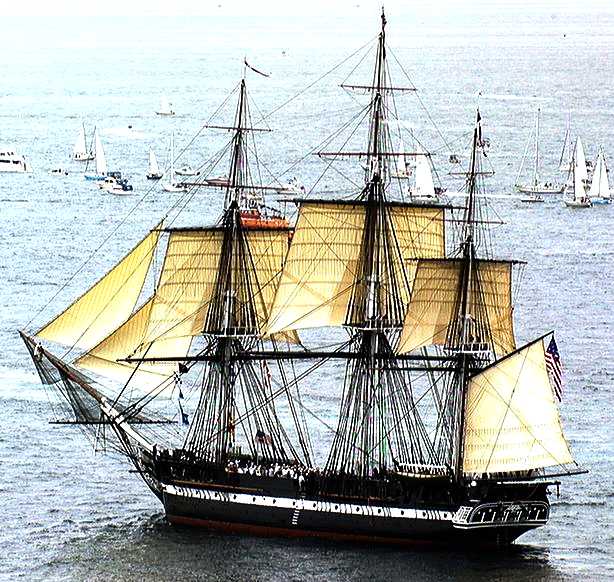
Tall ships in operation today - mainly for training purposes.
ATTEMPTS TO AUTOMATE SAILING
Starting in 1902 the sail ship Preussen was the first to automate handling of sails by making use of steam power without auxiliary engines for propulsion. The steam power were used for operation of the winches, hoists and pumps. A similar ship Kruzenshtern, which was a very large sailing vessel without mechanized control, had a crew of 257 men; compared the Preussen, which succeeded to reduce this number to 48 men.
In 2006, automated control was taken to the point where sailing can be operated by one person using a central control unit on the boat using DynaRig. The DynaRig technology was first developed in the 1960s in Germany by W. Prolls as a propulsion alternative for commercial ships to handle a possible future energy crisis. The technology is a high-tech version of the same type of sail used by the Preussen, the "square-rigger". The main difference is that the yards do not swing around a fixed mast but are attached permanently to a rotating mast. DynaRig along with extensive computerization was used in the proof-of-concept Maltese Falcon to enable it to be sailed with no crew in the rigging.
As of 2013 with increasing restrictions on use of cheap dirty bunker fuel attempts were underway to develop hybrid sailing ships using automated sail and alternative fuels.
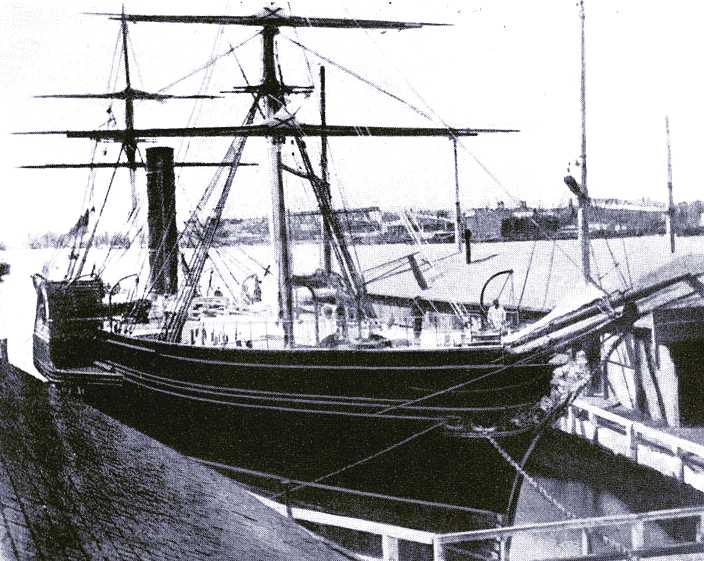
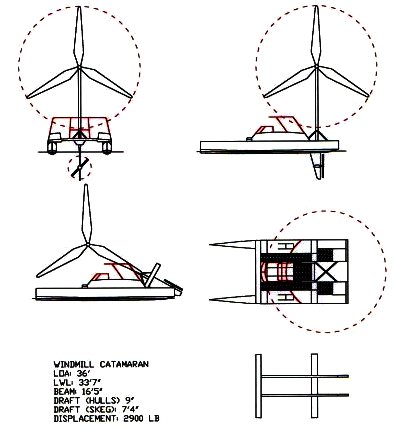
TECHNOLOGY TRANSITION: The RMS Europa from 1848 heralds the change from sail to
steam power. This was not done all at once, but as a gradual exit from sailing
ships to steam ships. ROTARY SAILS: Brad Blackford's conceptual design drawings
for boats powered by rotary sails. Any transition of technology will be out of
necessity - and it will be gradual, for all the same reasons as from sail to
steam. The key to change is a champion who
is willing to develop something that nobody else can see a future for.
THE
MALTESE FALCON The Maltese Falcon
was built by Perini Navi in Tuzla, Turkey. She is a ship-rigged luxury
sailing yacht, commissioned and formerly owned by American venture capitalist Tom Perkins. It is one of the largest privately owned sailing yachts in the world at 88 m (289 ft), similar to Royal Huisman's Athena and Lürssen's Eos. The yacht was sold in 2009 to Elena Ambrosiadou the founder of IKOS Ltd., the Cyprus-based hedge fund.
DYNASHIP CONCEPT
It was built after the dynaship concept, a 1960s invention of the German hydraulics engineer Wilhelm Prölss, which was intended to operate commercial freight sailing ships with as few crew as possible. The ship has fifteen square sails (five per mast), stored inside the mast; they can fully unfurl into tracks along the yards in six minutes. The three carbon fiber masts, which are free-standing and able to rotate, were manufactured and assembled by a company financed by Perkins at the Perini Navi Istanbul "Yildiz Gemi" (literally: Star Ship) yard in Tuzla, 50 mi (80 km) east of Istanbul, Turkey, under the supervision of the English company Insensys and Dutch company Gerard Dijkstra & Partners. Other design was provided by Ken Freivokh Design. The Maltese Falcon was the third yacht built by Perini for Perkins.
The yacht is easily controlled and has been seen to sail off her anchor and away from berths within harbors. The yacht's sophisticated
computer detects parameters such as wind speed automatically and displays key data. An operator must always activate the controls, yet it is possible for a single person to pilot the yacht. In a radio interview for the BBC World Service's Global Business programme broadcast in December 2007, Perkins claimed that he personally wrote some of the yacht's unique control software.
The Maltese Falcon has two 1,800 horsepower (1,300 kW) Deutz engines running at 1,800 rpm with a top speed of 20 kn (23 mph; 37 km/h) with minimal wave-making and virtually no vibration or noise and with a smooth and non-turbulent wake.
The yacht has a permanent crew of 18 to maintain the technical aspects, including the rig and to operate the onboard "hotel", which can accommodate twelve guests plus four guest staff. The boat also includes an onboard gourmet chef and stewards and stewardesses.
The Maltese Falcon was registered in Valletta, Malta in 2006. It completed its trial sail in the Sea of Marmara to the Bosphorus strait on 12 June 2006, and made its maiden voyage from Turkey to Italy via Malta in July 2006. The Maltese Falcon currently charters for between €400,000 to €420,000 per week, plus expenses.
On 4 November 2007, in a 60 Minutes profile, Perkins suggested the yacht cost more than $150 million, but less than
$300
million, refusing to be more specific.
Perkins and the yacht were the subject of a prize-winning biography, Mine's Bigger: Tom Perkins and the Making of the Greatest Sailing Machine Ever Built, by Newsweek's David A. Kaplan. The book in 2008 won the prestigious Gerald Loeb Award for best business book of the year.
The Maltese Falcon was listed for sale in 2006 on Yachtworld.com, with an asking price of €99 million with engine hours listed at 1,890 hours. Perkins sold the yacht for £60 million in July 2009.
There is now a new and improved Maltese Falcon sailing yacht design concept as unveiled by Perini Navi Italy, complete with the same type of rotating rig. The new 102-metre Falcon yacht design is larger, faster and better according to Perini.
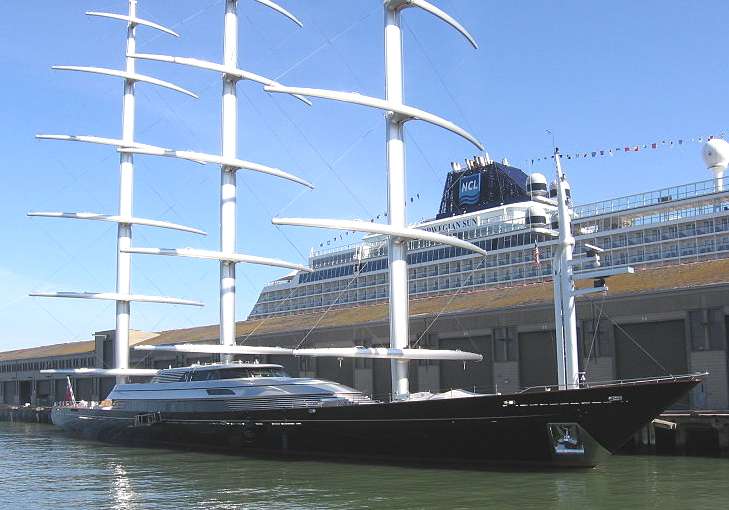
TECHNOLOGY TRANSITION: The Maltese Falcon with sails furled and yards 90 degrees
to the beam. The ability to rotate the yards greatly increases square rig efficiency.
The Falcon is a motor-sailor, with large diesel engines in reserve.
THE DYNA RIG
Damon Roberts of Insensys, Ltd. was responsible for designing and manufacturing the DynaRig sail system of The Maltese Falcon in the
Turkish shipyard. The design, testing and manufacturing of the system was completed over a three-year period. All aspects of the system were incorporated and tested to ensure that the design and finite element analysis matched the actual loads whilst sailing.
Costing $80 million dollars, the DynaRig owes its origin to work done in the 1960s by Wilhelm Prölss; at the time he believed the system could provide additional propulsion for ships. The DynaRig is effectively a square rig, the mast is freestanding and the yards are connected rigidly to the mast. In this case each mast supports six yards. The yards, unlike a conventional square rigger, have built-in camber of 12%. The sails are set between the yards in such a way that when deployed there are no gaps to the sail plan, enabling each mast's sail plan to work as a single sail. The sails, when not deployed, furl into the mast. The sail is trimmed to the wind direction by rotating the mast. As there is no rigging, the yards have no restriction on rotation and this, taken together with the curved (shaped) yards, low windage and effective single-piece sail, combine to give the rig improved aerodynamic efficiency compared to a traditional square rigger.
The masts are approximately 58 m (190 ft) in height above the bottom bearing. The DynaRig concept calls for an elongated section (to reduce the drag) and this needs to be symmetrical. As the rig can be tacked to allow flow in both directions, the mast rotates about deck and keel bearings.
Insensys also incorporated their fiber optical strain monitoring system that monitors the loads on the rigs to ensure that the carbon fiber structures are never overloaded whilst the yacht is sailing. The fiber Bragg grating system was embedded within the rigs during fabrication of the carbon structure. The system monitors the strains in real time and transmits the loads to the bridge such that they are understood whilst sailing.

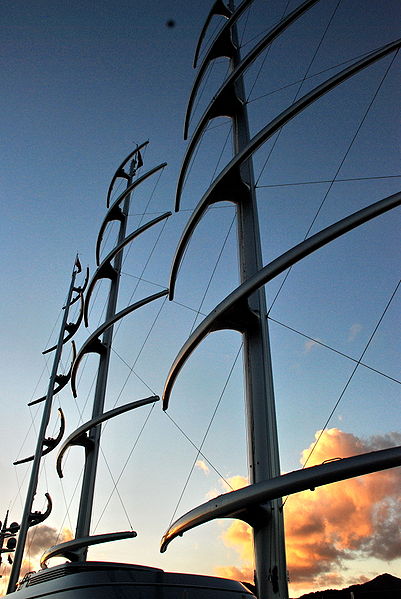
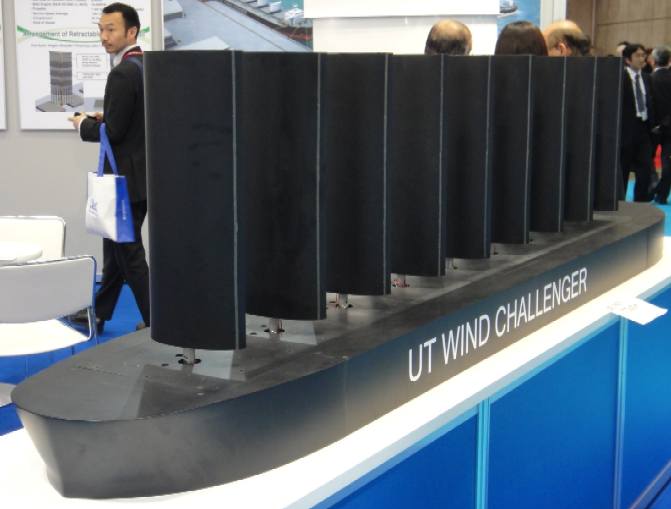
The Maltese Falcon with sails furled and yards 90 degrees
to the beam (top row, left & right). A model of the proposed University
of Tokyo 'UT Wind Challenger' (above).
AWARDS
Some of the awards The Maltese Falcon has won:
* 2011 Perini Navi Cup
* 2009 Perini Navi Cup
* 2007 International SuperYacht Society — Best S/Y over 36 m
*2007 Showboats international Award — highest technical achievement in a sailing yacht
* 2007 Showboats international Award — best sailing yacht interior
* 2007 Showboats international Award — best sailing yacht over 40
* 2007 Showboats international Award — most innovative sailing yachts
* 2007 Boat International World SuperYacht Award — Sailing Yacht of the Year
* 2007 Boat International World SuperYacht Award — Best Sailing Yacht 45m and above
* 2007 Boat International World SuperYacht Award — Best Sailing Yacht Interior
* 2006 Vela e Motore — Superyacht dell'anno 2006
* 2006 Yacht Capital BMW Award
|
.
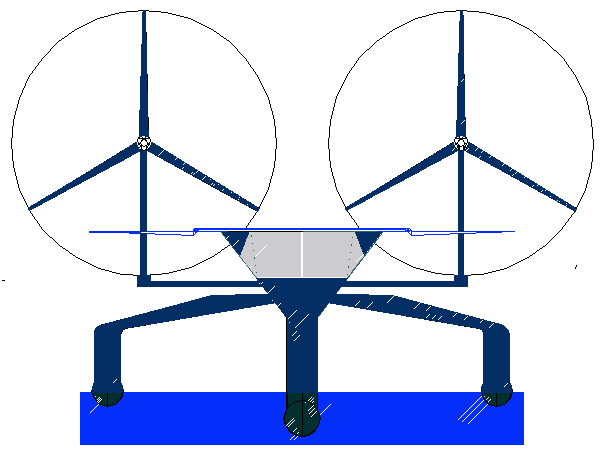
|
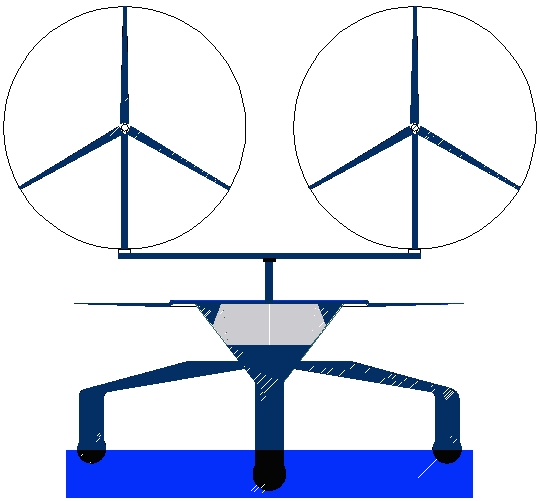
|
|
Bluefish
ZCC - Low operation mast height |
Bluefish
ZCC - Medium operational mast height |
As
with the Maltese Falcon, the Bluefish ZCC above controls the efficient
management of its 40kW wind turbines
using a dedicated microchip controller, independent of any onboard
navigation computers. A luxury yacht
expanding on the concept is planned, taking the 50 ton displacement to 200+
tons, to be able to accommodate state rooms and crew quarters. The Energy Harvested to Displacement ratio (EH/D)
will remain in the region of 3.52kW/ton (4.72hp/ton). Cruise speed will be
in the 10 knot bracket and the top speed of this craft will be around 20 knots
-
dependent on motor final specifications. There is no diesel fuel cost in normal
operation, and when docked the ship can power a small village in
emergencies. Other yachts just look pretty in dock. Fuel for
thought!
LINKS
http://en.wikipedia.org/wiki/The_Maltese_Falcon_(yacht)
http://en.wikipedia.org/wiki/Kruzenshtern_(ship)
http://en.wikipedia.org/wiki/Preu%C3%9Fen_(ship)
http://en.wikipedia.org/wiki/Sailing_ship
http://en.wikipedia.org/wiki/Windmill_ship
http://en.wikipedia.org/wiki/Bunker_fuel#Bunker_fuel
http://www.sodercan.es/
http://www.leow.de/boatbarn/jrwindm.htm
http://www.freepatentsonline.com/6902447.html
http://blog.modernmechanix.com/wind-propeller-sails-proposed-for-liners/
http://en.wikipedia.org/wiki/Rotor_ship
http://www.sailwings.net/art.html
http://www.sailwings.net/rotaryhome.html
http://www.windthrusters.com/
http://www.sailwings.net/
Worlds-first-fuel-cell-ship-e2809eFCS-ALSTERWASSERe2809c-proves-ist-reliability-1780
http://www.ecomarinepower.com/wind-and-solar-ships
http://www.maritimejournal.com/news101/marine-renewable-energy/eu-funding-for-renewables-research-facilities
http://www.bluefishplc.com/indian-wind-farm-project/
http://www.bluefishplc.com/bluefish-in-the-community/

|












